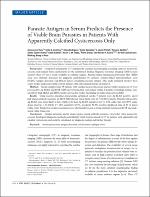| dc.contributor.author | Zea-Vera, Alonso | |
| dc.contributor.author | Cordova, Erika G. | |
| dc.contributor.author | Rodriguez, Silvia | |
| dc.contributor.author | Gonzales, Isidro | |
| dc.contributor.author | Pretell, Edwin Javier | |
| dc.contributor.author | Castillo, Yesenia | |
| dc.contributor.author | Castro-Suarez, Sheila | |
| dc.contributor.author | Gabriel, Sarah | |
| dc.contributor.author | Tsang, Victor C. W. | |
| dc.contributor.author | Dorny, Pierre | |
| dc.contributor.author | Garcia, Hector H. | |
| dc.date.accessioned | 2019-05-17T21:01:14Z | |
| dc.date.available | 2019-05-17T21:01:14Z | |
| dc.date.issued | 2013-06 | |
| dc.identifier.citation | Clinical Infectious Diseases. 2013; 57 (7) | es_PE |
| dc.identifier.issn | 1058-4838 | |
| dc.identifier.uri | https://hdl.handle.net/20.500.12959/549 | |
| dc.description.abstract | Estudio que evalúa si los exámenes de ELISA (enzyme-linked immunosorbent assay) y Ag-ELISA (antigen detection) predicen quistes viables en pacientes con lesiones calcificadas en el cerebro no detectados en tomografía computarizada. Se procesaron con Ag-ELISA y con inmunoelectrotransferencia enzimática, muestras de suero de 39 pacientes con neurocisticercosis calcificada y parásitos no viables en tomografía computarizada; se realizó resonancia magnética a cada paciente con dos meses de prueba serológica. Se concluye que la detección de antígenos y un grado menor de reacciones a anticuerpos pueden predecir neurocisticercosis viable. Los métodos de diagnóstico serológico podrían identificar lesiones viables no encontradas por tomografía computarizada, en pacientes con aparentemente sólo cisticercosis calcificada. | es_PE |
| dc.description.abstract | Background. Computed tomography (CT) remains the standard neuroimaging screening exam for neurocysticercosis, and residual brain calcifications are the commonest finding. Magnetic resonance imaging (MRI) is more sensitive than CT but is rarely available in endemic regions. Enzyme-linked immunoelectrotransfer blot (EITB) assay uses antibody detection for diagnosis confirmation; by contrast, enzyme-linked immunosorbent assay (ELISA) antigen detection (Ag-ELISA) detects circulating parasite antigen. This study evaluated whether these assays predict undetected viable cysts in patients with only calcified lesions on brain CT.
Methods. Serum samples from 39 patients with calcified neurocysticercosis and no viable parasites on CT were processed by Ag-ELISA and EITB. MRI was performed for each patient within 2 months of serologic testing. Conservatively high ELISA and EITB cutoffs were used to predict the finding of viable brain cysts on MRI.
Results. Using receiver operating characteristic–optimized cutoffs, 7 patients were Ag-ELISA positive, and 8 had strong antibody reactions on EITB. MRI showed viable brain cysts in 7 (18.0%) patients. Patients with positive Ag-ELISA were more likely to have viable cysts than Ag-ELISA negatives (6/7 vs 1/32; odds ratio, 186 [95% confidence interval, 1–34 470.0], P < .001; sensitivity 85.7%, specificity 96.9%, positive likelihood ratio of 27 to detect viable cysts). Similar but weaker associations were also found between a strong antibody reaction on EITB and undetected viable brain cysts.
Conclusions. Antigen detection, and in a lesser degree strong antibody reactions, can predict viable neurocysticercosis. Serological diagnostic methods could identify viable lesions missed by CT in patients with apparently only calcified cysticercosis and could be considered for diagnosis workup and further therapy. | |
| dc.format | application/pdf | es_PE |
| dc.language.iso | eng | es_PE |
| dc.publisher | Infectious Diseases Sociedty of America | es_PE |
| dc.relation.uri | https://academic.oup.com/cid/article/57/7/e154/337081?login=false | |
| dc.rights | info:eu-repo/semantics/openAccess | es_PE |
| dc.rights.uri | https://creativecommons.org/licenses/by-nc-nd/4.0/ | es_PE |
| dc.source | Seguro Social de Salud (EsSalud) | es_PE |
| dc.source | Repositorio Institucional EsSalud | es_PE |
| dc.subject | Parasitología | es_PE |
| dc.subject | Neurocisticercosis | es_PE |
| dc.subject | Técnicas y procedimientos diagnósticos | es_PE |
| dc.subject | Neurocysticercosis | |
| dc.subject | Antigen detection | |
| dc.subject | Calcifications | |
| dc.subject | Epilepsy | |
| dc.title | Parasite antigen in serum predicts the presence of viable brain parasites in patients with apparently calcified cysticercosis only. | es_PE |
| dc.type | info:eu-repo/semantics/article | es_PE |
| dc.subject.ocde | https://purl.org/pe-repo/ocde/ford#3.03.05 | es_PE |
| dc.subject.ocde | https://purl.org/pe-repo/ocde/ford#3.03.02 | es_PE |
| dc.publisher.country | PE | es_PE |
| dc.identifier.doi | https://doi.org/10.1093/cid/cit422 | |






